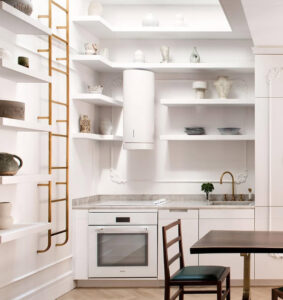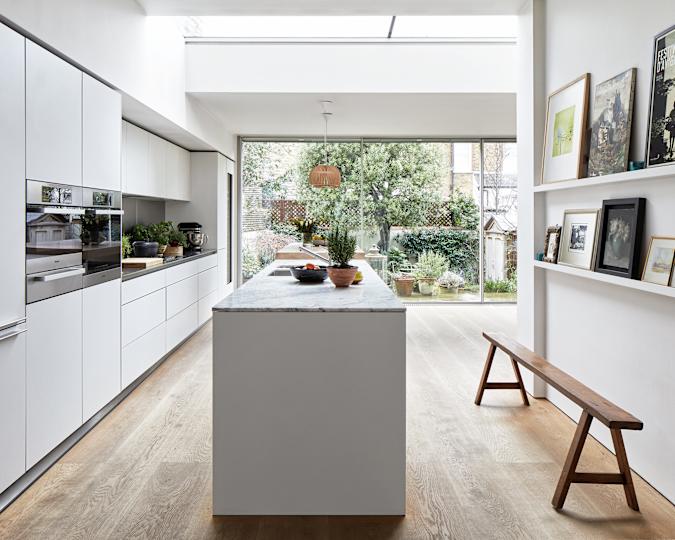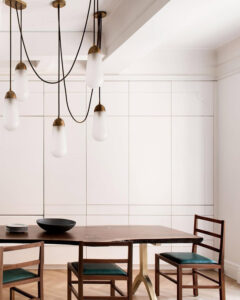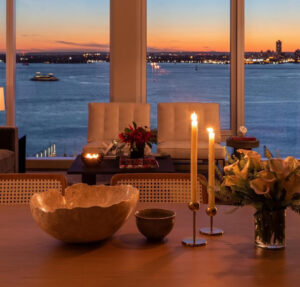
In an era defined by maximalism and performative lifestyle aesthetics, Anne Hathaway’s New York City apartment whispers where others shout. Tucked away in a historic building in Manhattan’s Upper West Side, the space doesn’t just house an Oscar-winning actress and her family — it tells a story of restraint, intentionality, and radical intimacy. At the center of that story is an architectural enigma: the “invisible kitchen.” Unbranded. Unassuming. Nearly imperceptible. Yet once noticed, impossible to forget.
This isn’t a kitchen that brags — there are no open shelves of curated ceramics, no artisanal spice displays or imported espresso machines acting as social signals. Instead, the kitchen seems to vanish entirely into the architecture. Flush cabinetry merges with the walls, appliances are cloaked in matte surfaces, and handles are absent — replaced by touch-latch mechanisms or concealed grooves. It’s less a room and more an architectural sleight-of-hand, a functional illusion embedded within a minimalist philosophy. And it’s quietly rewriting the codes of domestic space in luxury real estate.
THE ART OF DISAPPEARING: AESTHETIC MINIMALISM WITH MAXIMUM INTENTION
To describe the invisible kitchen as “minimalist” is both true and insufficient. Minimalism, as a design movement, has become a diluted term — associated as much with Instagram decluttering guides as with the philosophical rigor of Mies van der Rohe. Hathaway’s kitchen does not aim for visual silence merely for the sake of aesthetic cleanliness. It pursues discretion as an ethical and emotional gesture. In a world where the kitchen has become the performative stage of lifestyle branding — with “shelfies,” viral TikTok pantries, and influencer copper pot racks — this kitchen offers a refusal.
Instead of spectacle, it offers integration. The fridge, oven, dishwasher — all are masked behind matte-finished panels, identical to the surrounding cabinetry. The sink folds seamlessly into the countertop. Lighting is embedded subtly into shadow gaps or recessed planes. The surfaces are tactile yet unassuming — a palette of soft putty tones, cool limestone, brushed oak veneer. The only clue that this wall of symmetry hides a functioning kitchen is the faint acoustics of running water or the distant click of a toaster drawer.
In Hathaway’s home, the kitchen is not a space to be admired but to be inhabited. Its purpose is not visibility, but utility — and its luxury is in its intelligence, not its opulence.
FROM LABOR TO LEISURE: A FEMINIST REFRAMING
The invisible kitchen is also a subversion of domestic gender politics. For decades, the kitchen has been both a site of labor and spectacle — a room historically tied to women’s unpaid work and, later, to aspirational homemaking. In traditional layouts, the kitchen was hidden behind a swinging door. Then came the open-plan revolution, which brought the kitchen to center stage, turning it into a hub of performance. In contemporary luxury apartments, kitchens are designed as statements: statement islands, statement backsplashes, statement ranges.
By disappearing the kitchen, Hathaway — or more precisely, the architects she entrusted — is participating in a reframing of the domestic gaze. The labor of cooking is no longer center stage, nor is it tucked away in shame. Instead, it is integrated into the holistic design of the home, demystified but also de-spectacularized. The kitchen becomes just one part of the living narrative, not a performative node.
It’s a shift reminiscent of modernist ideals seen in the work of Charlotte Perriand or Eileen Gray — women who understood that true freedom in design often came from refusing ornament and insisting on flow. In Hathaway’s home, that lineage is extended: a home designed not to impress guests, but to soothe its inhabitants.
THE RISE OF THE ANTI-KITCHEN
This isn’t an isolated case. Across elite architecture circles in New York, Copenhagen, Tokyo, and Berlin, the “anti-kitchen” — a term now used colloquially among interior specialists — is becoming an increasingly aspirational marker of wealth. It signals a rejection of the loud-and-proud kitchen showroom aesthetic in favor of a more coded, more discreet luxury. Where once status was communicated through Sub-Zero refrigeration and marble veining, now it’s whispered through seamless cabinetry and the absence of visual interruption.
The paradox is striking: hiding the kitchen, rather than showcasing it, has become the new elite gesture. It requires more engineering, more customization, more expense — not less. Flush cabinetry must be meticulously measured. Ventilation systems need to be silent. Drawers must open at precisely calibrated pressures. Appliances must be selected for their acoustic profiles as much as their finish.
To make a kitchen invisible is not to minimize its importance, but to elevate it — to treat it as worthy of architectural integration rather than domestic theater. Hathaway’s home exemplifies this paradox beautifully. It is an act of quiet dominance.
A PSYCHOLOGY OF STILLNESS
Beyond its visual charm, the invisible kitchen serves an emotional function. It creates a psychological clarity — a space that doesn’t demand attention, that allows the mind to rest. In a home occupied by public figures, where privacy is precious and overexposure constant, such environments offer rare reprieve. Hathaway has spoken in interviews about the importance of protecting her family’s inner life, of building environments that are functional sanctuaries rather than decorative showrooms.
The invisible kitchen is part of this spatial ethos. It allows the home to flow without interruption, to breathe. There is no constant reminder of dishes to be done, no clutter anxiety triggered by appliance sprawl. There is just a surface — quiet, cool, receding — until needed.
This design philosophy draws deeply from Japanese and Scandinavian traditions. It echoes the wabi-sabi reverence for absence, the Danish belief in hygge as felt warmth rather than visual stimulation. It is space as psychology, not just sculpture.
WHO BUILT THIS? THE ARCHITECTURAL BRAINS BEHIND THE MAGIC
While Hathaway remains gracefully private about the identities of her home’s designers, several names in the high-design residential sphere have been rumored to influence the space: Michael Ingui of Baxt Ingui Architects, known for restoring historic brownstones with rigor and minimalism; Studio Giancarlo Valle, whose work straddles the line between cosmopolitan eclecticism and structural serenity; and even the Belgian minimalist master Vincent Van Duysen, whose influence on the invisible kitchen trend is unmatched.
Whomever the architect, the execution is meticulous. To design a space that feels simple but works flawlessly is among the hardest challenges in interior architecture. Every concealed hinge, flush edge, and drawer runner must be tuned to perfection. The tolerances are as precise as in high watchmaking.
Such refinement doesn’t happen by accident. It is the result of obsessive craftsmanship — cabinetry built to disappear, lighting designed to simulate daylight without casting a glare. It is luxury disguised as modesty, restraint as theater.
ANTI-TRENDS AS THE NEW TRENDS
Ironically, the “invisible kitchen” has become a trend precisely because it resists trendiness. In a digital age defined by saturation and overstatement, invisibility becomes a form of counterprogramming. It draws the gaze by refusing it. Like quiet luxury in fashion — see Gwyneth Paltrow’s courtroom cashmere or Zegna’s ultra-soft, logo-less tailoring — this style of design operates through subtraction.
Hathaway’s kitchen, therefore, joins a larger movement across celebrity and architectural culture: a movement away from branding, from over-identification, and toward something more elusive. Something private. The opposite of a YouTube kitchen tour.
But what makes Hathaway’s invisible kitchen different from the others — what elevates it — is not merely its execution, but its context. This is a kitchen housed within a lived-in space. Not an empty architectural temple. There are books, children’s toys, soft corners, and daily routines. The kitchen’s disappearance does not sterilize the home — it frees it to feel like one.
Impression
The invisible kitchen in Anne Hathaway’s NYC apartment is not a gimmick, nor a design flex for the sake of aesthetic innovation. It is a meaningful gesture in domestic architecture — a move away from performance and toward presence, away from spectacle and toward stillness. In refusing to be seen, it reveals something deeper about how we live, and what we choose to reveal.
It tells us that luxury is no longer about what you have, but what you don’t feel the need to show. That real taste doesn’t require validation. That a kitchen can cook, clean, host, and then disappear — leaving only the echo of quiet mastery in its place.
In this way, Hathaway’s invisible kitchen becomes more than a trend. It becomes a philosophy. A quiet, powerful act of hiding in plain sight.
No comments yet.









